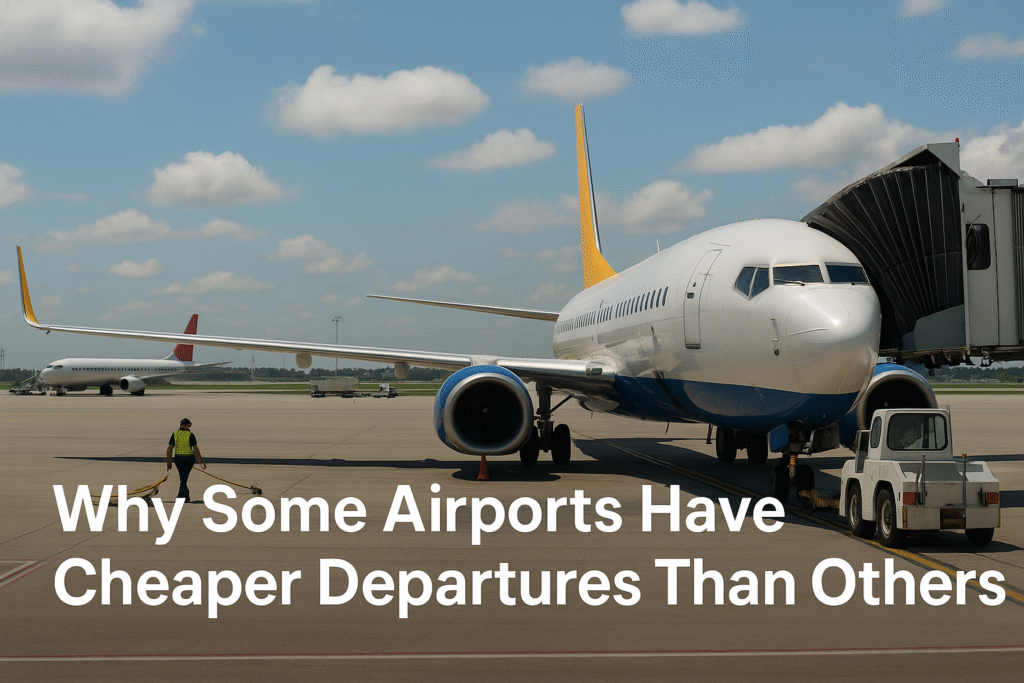Why Some Airports Have Cheaper Departures Than Others

✈️ Ever wonder why flights from one airport cost way less than another nearby? Here’s what’s really happening—and how you can use it to your advantage.
Table of Contents
You find a great flight online. But just before you book, curiosity strikes: “What if I left from another airport?” You type it in… and boom—same airline, same day, same destination, but $300 cheaper.
That’s not a glitch. There’s a reason why departures from some airports cost less. And if you understand how it works, you can travel smarter—and save more.
Let’s break it down 👇
🏙️ How airport competition shapes your fare
Some airports fight for your business. Others don’t need to.
When a city has multiple airports (think London, New York, Bangkok), airlines often lower prices to compete. If you can choose between two or three airports, they know you’re flexible—so they work harder to win you.
On the flip side, smaller cities with just one airport don’t face that pressure. Less competition means higher fares.
💡 Tip: Always check airports within 2 hours of you. Even a short bus ride can save a few hundred bucks.
💸 Hidden fees that make a big difference
Airfare isn’t just about the airline. Airports charge taxes, security fees, and surcharges—often invisible at first glance.
For example:
- Heathrow ✈️ = high departure taxes
- Lisbon or Athens = low airport fees
- U.S. airports = often sneak in facility charges
What looks like an airline issue might actually be an expensive airport.
💡 Tip: Use a booking engine or AI search tool that shows taxes separately. Some airports are sneakier than others.
🛬 Budget airlines love smaller airports
Low-cost carriers avoid premium airports. That’s how they keep fares so low.
Think Ryanair flying from Beauvais instead of Paris CDG. Or AirAsia skipping Bangkok’s main hub.
Smaller airports = lower landing fees = cheaper tickets for you.
💡 Tip: If cost matters more than comfort, check nearby secondary airports—they often hide the real bargains.
🌍 Major hubs offer more deals
Large international hubs have way more flights per day. That leads to:
- More competition
- More flexibility
- More promotional fares
Big airports = price pressure.
Small airports = limited options = higher prices.
💡 Tip: Consider taking a train, bus, or short domestic flight to a hub. You may save enough to make it worth it.
📅 Demand is different everywhere
Different cities, different travel patterns.
- Tourist destinations: cheaper in low season
- Business hubs: more expensive last-minute
- Event cities: price spikes around holidays or conferences
Your departure city might be expensive right now, but a nearby one might not.
💡 Tip: Watch for local school breaks, festivals, or elections. Flights from those areas go up fast.
🌐 Currency and location affect what you see
Geo-pricing is real. Some airlines adjust fares based on where you book from—even for the exact same flight.
You might get a better fare searching in local currency or using a VPN set to another country.
💡 Tip: Use AI tools like Fly GPT to simulate different locations or currencies. The same route can drop by 20–30% with a simple change.
🛫 Airline loyalty starts at their home airport
Airlines give the best fares where they’re based. It’s easier for them to run more flights and offer deals.
Examples:
- Emirates: better fares from Dubai
- LATAM: cheaper departures from Santiago
- Turkish Airlines: lower prices out of Istanbul
💡 Tip: Know your airline’s home turf. Starting your trip from their base often means cheaper tickets and more flight options.
🏛️ Economics and politics influence airport pricing
Sometimes cheap fares come from government decisions, not market forces.
Countries may:
- Lower airport fees to boost tourism
- Subsidize airlines after crises
- Offer deals during rebuilding efforts
💡 Tip: If a country is reopening or pushing tourism hard, you’ll likely find deals flying out from there.
💼 Airports offer behind-the-scenes discounts
When airports want more flights, they often incentivize airlines with discounts.
That can lead to:
- New route promos
- Short-term fare drops
- Hidden deals most travelers miss
💡 Tip: Sign up for newsletters or follow airlines on X (Twitter). New routes often launch with super low prices.
🔁 Return flights aren’t priced the same
Here’s a surprise: your return ticket may cost more than the outbound.
Why? Because tourists are more flexible on the way to a place. But heading home? Airlines know you’re locked in.
💡 Tip: Break your round-trip into two one-ways. You might find it’s cheaper to return from a different city or airport nearby.
🎯 What you should do next
Before clicking “Book,” take 5 minutes to:
✅ Compare nearby airports
✅ Look at round-trip vs. one-way pricing
✅ Use geo-pricing or AI tools
✅ Check for events or high seasons
✅ Consider budget airlines at smaller airports
The city you leave from shapes your entire trip cost. The more flexible you are, the more tricks you can use.
Want a shortcut?
Let AI do the heavy lifting. Try Fly GPT, the flight assistant that finds hidden deals, airport hacks, geo-priced routes, and flexible date combos—all in one chat.
👉 https://fromtoflights.com/FlyGPT
